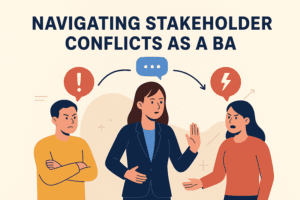
Introduction
Think of a scenario in which all project stakeholders are aligned, content, and productive. Pretty amazing, right? Well, this could be your reality– if mastering stakeholder conflict resolution in your role as a Business Analyst (BA) – is a priority. No project is without conflicts. Different departments, goals, timelines, and success metrics guarantee that. Conflicts don’t destroy projects. The lack of a conflict resolution framework and poorly managed stakeholder dynamics does. Here, we look at a few unsatisfactory stakeholder dynamics and how a professional BA is able to change the attitude of the parties involved.
1. The Silent Saboteur: Why Conflicts Threaten Your Project
Unresolved stakeholder conflicts are like silent project killers — they often go noticed until the damage is done. Hidden Costs of Stakeholder Disagreements The fallout that can arise when Business Analysts take the wrong approach to stakeholder conflict can look like the following: Missed deadlines: Endless debates delay decisions. Scope creep: Disagreements over requirements lead to unapproved changes. Team morale dips: Frustration spreads when priorities clash.
💡 Real-World Scenario:
A BA working on a healthcare project once faced conflicting demands between doctors and IT staff. The doctors wanted a user-friendly interface; the IT team prioritized data security. Because the BA didn’t mediate early, development stalled for two months, costing the project valuable time and budget.
Now, imagine if that BA had facilitated a structured discussion early — the conflict could have turned into collaboration, blending usability with compliance.
Ask yourself: What if you could turn conflict into collaboration instead of confrontation?
2. Proactive Policing: Identifying Conflict Triggers Early
The best Business Analysts don’t wait for conflicts to explode — they detect them before they start.
Spot the Red Flags
Early signs of stakeholder tension often include:
Differing business priorities (e.g., finance wants cost savings; marketing wants features).
Ambiguous or incomplete requirements.
Communication gaps between technical and non-technical teams.
BA Techniques to Predict Friction Points
A skilled BA uses stakeholder mapping and power/interest grids to identify potential conflict sources. These tools help visualize:
Who holds decision-making power.
Who is most affected by project outcomes.
Where misalignments may arise.
Uncovering Unspoken Concerns
Use active listening and probing questions like:
“What’s your biggest concern about this change?”
“How would this decision affect your team’s workflow?”
These open-ended questions allow stakeholders to express hidden fears and prevent conflicts from festering.
3. Your BA Toolkit: Strategies for Conflict Resolution
Once conflicts arise, your role as a Business Analyst is to act as a neutral mediator who focuses on solutions, not blame.
Practical Frameworks
The Thomas-Kilmann Conflict Mode Instrument (TKI) offers five proven approaches:
Competing: Assertive approach when quick decisions are needed.
Collaborating: Win-win solution through open dialogue.
Compromising: Each side gives up something for mutual benefit.
Avoiding: Useful when emotions are high — delay to cool down.
Accommodating: Prioritize harmony for minor issues.
👉 Example:
In a finance project, two department heads disagreed on report formats. The BA used the collaborating approach — organized a joint workshop, compared both options, and created a hybrid format that satisfied both sides.
Depersonalize the Disagreement
Focus on the issue, not the individual:
Use neutral language (“Let’s explore both perspectives”)
Avoid assigning blame (“You caused delays”)
Summarize shared goals to realign focus
Scripts for Difficult Conversations
When tensions rise, a BA can use these phrases:
“I understand both of your concerns. Let’s revisit the project objective together.”
“Can we list what success looks like for each of you?”
“Let’s prioritize based on impact rather than preference.”
By maintaining composure and clarity, a BA becomes the calm center in a storm of opinions.
4. Beyond Resolution: Building Bridges for Future Success
Conflict resolution isn’t the end; it’s the beginning of better collaboration. Once harmony is restored, a BA’s job is to strengthen relationships for future projects.
Post-Conflict Reflection
After each disagreement:
Conduct a short lessons learned session.
Document what triggered the conflict and how it was resolved.
Share takeaways in your BA knowledge repository.
Build Continuous Trust
Recognize stakeholders’ contributions publicly.
Maintain open communication even after project closure.
Encourage transparency for future discussions.
When stakeholders trust you as a neutral facilitator, they’re more likely to cooperate in upcoming initiatives — making you not just a BA, but a trusted advisor.
Conclusion
Conflicts are inevitable in business analysis — but chaos isn’t.
By applying proactive identification, structured negotiation, and empathetic communication, Business Analysts can transform stakeholder conflicts into collaborative breakthroughs.
So, the next time tensions rise in a project meeting, remember: you hold the power to turn disagreement into progress. That’s the mark of an exceptional Business Analyst.
🔗 Related Articles:
🌍 External References (High Authority Links):

Business Analyst , Functional Consultant, Provide Training on Business Analysis and SDLC Methodologies.
